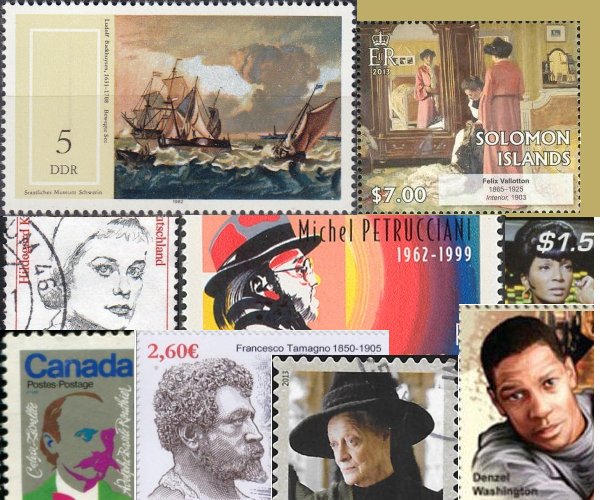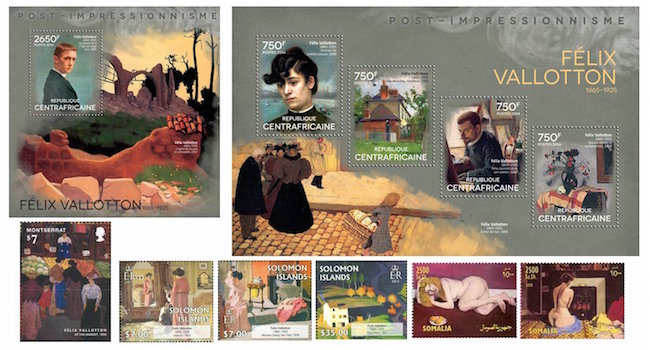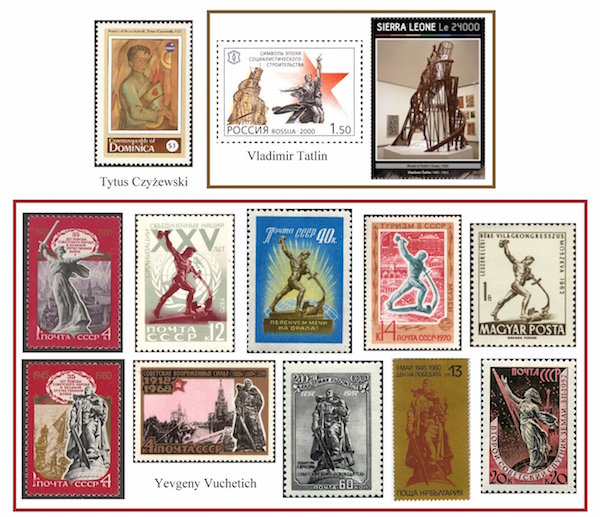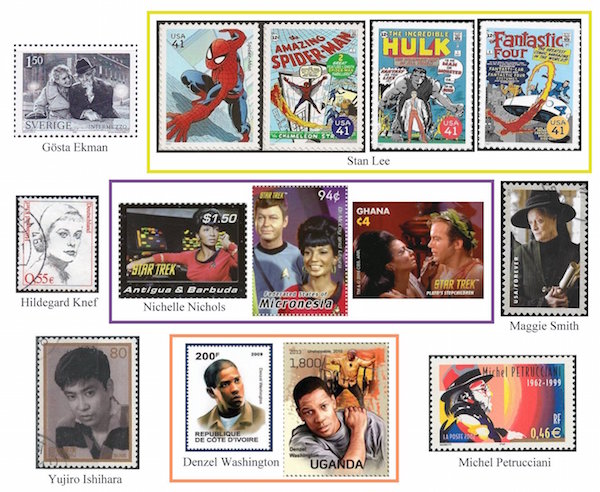The Arts on Stamps of the World — December 28
An Arts Fuse regular feature: the arts on stamps of the world.

By Doug Briscoe
Today we begin with a painter of the Dutch Golden Age, German-born Ludolf Bakhuizen (28 December 1630 – 17 November 1708), regarded as the leading maritime painter after the van de Veldes left Holland for England in 1672. He started his career in Amsterdam, where he arrived about 1650, as a calligrapher. Soon he turned to pen and ink drawings and, after studies with Allart van Everdingen and Hendrik Dubbels, to sea paintings. Not content with casual representations, Bakhuizen often went out in a boat in choppy seas or stormy conditions for authenticity. He acquired such a reputation that he was visited by such luminaries Cosimo III de’ Medici and Peter the Great. Bakhuizen was also active in printmaking. Two examples of his seascapes are found on stamps of East Germany and Romania.

The father of João Domingos Bomtempo (1775 – August 18, 1842) was an Italian musician living in Portugal. At the age of 25 João went to Paris to begin a career as a pianist. In 1822 he returned to Lisbon and founded a Philharmonic Society, later assuming the post of music teacher to Queen Maria II. When his old alma mater the Patriarchal Music Seminary was reformed as the National Conservatory of Portugal in 1835, he became its first Director. He is credited with having written the first two Portuguese symphonies, which have been recorded for Naxos, an opera, Alessandro in Efeso, and a Requiem, but otherwise his oeuvre is almost entirely devoted to piano music, including several concertos.
The composer of the music for “O Canada”, Calixa Lavallée (1842 – January 21, 1891), emigrated from Canada to the United States and served as a Union Army band musician during the Civil War. He also composed three comic operas and an operetta. The pair of stamps celebrating the anthem depicts Lavallée with Sir Adolphe-Basile Routhier, who penned the original lyrics (in French), and Robert Stanley Weir, whose English version (not a literal translation of the French) was made in 1908. “O Canada” has been the national anthem since 1967.
Cited by Wikipedia as the “most famous heroic tenor of his age”, the Italian Francesco Tamagno (28 December 1850 – 31 August 1905) sang extensively throughout Europe, the United States, and South America. He was the creator of the title role in Verdi’s Otello (at La Scala in 1887) and created the leading parts in five other operas. Tamagno made a number of recordings in the last two years of his life, though he was then past his prime and suffering from heart disease, of which he died at age 54. Monaco issued this stamp in his memory two years ago.
The number of stamps for the paintings of Félix Vallotton (December 28, 1865 – December 29, 1925) quite swamps the work of most of today’s other visual artists. Born in Lausanne, he was a great admirer of Holbein, Dürer, and Ingres and was strongly influenced by them. He became a French citizen in 1900. The stamps all concentrate on Vallotton’s paintings to the detriment of his many innovative woodcuts, the first of which, made in 1891, was a portrait of Paul Verlaine. Let’s begin with the CAR (Central African Republic) sheet that superimposes Vallotton’s 1885 Self-Portrait over L’eglise de Souain (1917); its companion piece offers up four pieces on the stamps, The Artist’s Mother (Portrait de Juliette Lacour, 1886), Ville Beaulieu, Honfleur (1909), Félix Josinski dans son atelier (1887), and Nature morte et autoportrait (1906), with Street Scene (Scène de rue, 1895) as a backdrop. From Montserrat comes At the Market (1895), and from the Solomon Islands Interior (1903), Woman Doing Her Hair (Femme se coiffant, 1900) and First Rays (1921); and from a Somalian sheet, Nude Blond Woman with Tangerines (1913) and Nude by Fireplace (1909).

Besides painting, the Pole Tytus Czyżewski (tchi-ZHEF-ski, 28 December 1880 – May 1945) wrote poetry and plays. He studied art in Kraków and Paris and first exhibited in 1906, his strongest influences being Cézanne and El Greco. Czyżewski developed into a theoretician and was a founder in 1917 of the Polish Formists, which group lasted until 1922. In that year, he relocated to Paris, where he remained until 1930, wrote three plays, and turned to surrealism. The bulk of his poetry dates from the twenties. The stamp, which comes from Dominica, shows Portrait of [futurist poet] Bruno Jasieński (1920).
Another Slavic avant-garde visual artist of the period was Vladimir Tatlin (28 December [O.S. 16 December] 1885 – 31 May 1953). While Czyżewski diversified into poetry and drama, Tatlin’s other areas of expertise (besides painting) were architecture, constructivist sculpture, and folk music—he sang professionally and played the bandura. (His mother was a poet, though.) His most famous conception is one that was never realized. This was the proposed Monument to the Third International, aka Tatlin’s Tower, a model of which is shown on two stamps, one from Russia and the other from Sierra Leone. The tower was projected to stand 400 meters (1312 ft) tall, which would have made it nearly 25% higher than the Eiffel Tower. Coincidentally, one of the contructed models of the tower resides in the Tretyakov Gallery (whose founder’s birthday we celebrated yesterday). Others exist outside London’s Royal Gallery and at the Pompidou Center in Paris. Born in Kharkiv, Tatlin went to sea as a cadet. An example of his painting is this self-portrait titled Seaman (1911).
Tatlin’s countryman and fellow sculptor Yevgeny Vuchetich (voo-TCHET-yitch, 28 December [O.S. 15 December] 1908 – 12 April 1974) shares with him also a Ukrainian birthplace (Yekaterinoslav) and the tendency to magnitude. His 1967 monument The Motherland Calls (see close-up here) was at the time of its completion stated to be the largest statue in the world, at 85m (279 ft) from the plinth to the tip of the sword. A memorial to the Battle of Stalingrad, it stands outside that city (since 1961 Volgograd, the original name from its founding in 1589 to 1925). Likely even more famous to Westerners is Let Us Beat Swords into Plowshares, donated to the United Nations in 1959 and showing up on at least three Soviet stamps and one from Hungary. Receiving at least equal attention is Vuchetich’s 1949 statue forming the centerpiece of the War Memorial in Berlin’s Treptower Park. The subject makes use of the rescue of a three-year-old German girl by a Soviet Guards sergeant who exposed himself to heavy fire to save her. It features, again, on three Soviet stamps plus one from Bulgaria. Finally, there is Vuchetich’s homage to Sputnik, To the Stars.
Earlier this year, on July 28th, the actor Gösta Ekman, who had appeared in Swedish films since the 50s, died in Stockholm at the age of 77. He was the namesake of his grandfather, and it is that Gösta Ekman (28 December 1890 – 12 January 1938) who concerns us today. He was renowned as a stage actor, cited for his ability to play a wide variety of characters through makeup and costume and for his sonorous voice. He was also a singer, director, and manager of several Stockholm theaters. He explored the possibilities of film from as early as 1912, his two most celebrated parts being the title role in F. W. Murnau’s Faust (1926) and Professor Brandt in the original Swedish version of Intermezzo (1936) opposite Ingrid Bergman, who would go on to star in the 1939 American remake with Leslie Howard in the Brandt role. The stamp gives us a still from the original Swedish film. Alas, there appears to be no stamp yet for the great German director Murnau (1888 – March 11, 1931), whose birthday also falls on December 28.

Happy 95th birthday to writer Stan Lee (born December 28, 1922), co-creator, with artists Jack Kirby and others, of American comic-book icons Spider-Man, X-Men, Iron Man, the Incredible Hulk, the Fantastic Four, and others. He was born Stanley Lieber in Manhattan to Romanian-born Jewish parents and started working at Timely Comics in 1939. Timely would eventually evolve into Marvel Comics. Lee was editor-in-chief for some thirty years. He has also appeared many times in films and on television, often portraying himself. All these stamps come from a single souvenir sheet issued by the USPS in 2007 recalling Marvel heroes. (Be not indignant, DC Comics fans, you got your sheet first, in 2006.)
Now we turn to the movies for a series of stars, beginning with Hildegard Knef (1925 – 1 February 2002). Like yesterday’s birthday girl Marlene Dietrich, she was a German actress and singer, though she took up singing only in the 1960s. She made 23 albums which sold three million copies and wrote the lyrics to 130 of the songs she recorded.
Nichelle Nichols (born Grace Dell Nichols on December 28, 1932) is best known for her groundbreaking role as Lt. Uhuru on Star Trek, a signal advance for African-Americans in that Uhuru was the first important black TV character who was not a servant. The Ghanaian stamp portrays the historic scene in which US television’s first interracial kiss was broadcast. The episode, “Plato’s Stepchildren”, was shown on November 22, 1968.
Dame Maggie Smith (born 28 December 1934) first trod the boards at 17 as Viola in Twelfth Night and made her film debut in 1956. Among her many, many awards she has twice won the Oscar, for Best Actress in The Prime of Miss Jean Brodie (1969) and for Supporting Actress in California Suite (1978). Smith has twice been married, to actor Robert Stephens from 1967 to 1974 and to playwright Beverley Cross from 1975 until his death in 1998. She’s been a CBE since 1970 and a DBE since 1990. The stamp is one of the Harry Potter set issued by the USPS in 2013—Smith wears her Professor McGonagall garb.

As it happens, Japanese actor Yujiro Ishihara (1934 – July 17, 1987) was not only born on precisely the same day as Maggie Smith but also made his film debut in 1956. This was in Season of the Sun, based on a novel that had been written by his elder brother Shintaro Ishihara, who would much later serve as Governor of Tokyo (1999-2012). Also a singer, Yujiro was thought of by many as a sort of Japanese Elvis Presley and also died rather young, at 52, of liver cancer.
Like Maggie Smith, Denzel Washington (born December 28, 1954) has won a great many awards and Oscars in the two acting categories, for Glory (Supporting Actor, 1990) and Training Day (Best Actor, 2002). He first appeared on stage in 1976, television in 1977, and film in 1981. His breakthrough role was on the popular series St. Elsewhere (1982-88). He had two big hits in 1993 with The Pelican Brief and Philadelphia. Last year he directed himself and a splendid ensemble cast in August Wilson’s Fences.
For today’s final entry we leave the movies and go to the world of jazz for French pianist Michel Petrucciani (28 December 1962 – 6 January 1999), who was afflicted with osteogenesis imperfecta and died at 36. As a result of his condition he suffered more than a hundred bone fractures before puberty, yet he came to view certain aspects of his disease as a blessing in disguise, as it “saved me from being ordinary.” He admired Duke Ellington and Bill Evans from early childhood and gave his first professional performance at 13. Just a few years later he was playing with Clark Terry. He came to the US in 1982 and lived in New York City from 1984 to his death fifteen year later. Appropriately enough, he is buried in Père Lachaise Cemetery next to Chopin.
Besides the philatelically neglected F. W. Murnau, American jazz great Earl Hines (December 28, 1903 – April 22, 1983) suffers like disregard stampwise.
A graduate of the University of Massachusetts with a B.A. in English, Doug Briscoe worked in Boston classical music radio, at WCRB, WGBH, and WBUR, for about 25 years, beginning in 1977. He has the curious distinction of having succeeded Robert J. Lurtsema twice, first as host of WGBH’s weekday morning classical music program in 1993, then as host of the weekend program when Robert J.’s health failed in 2000. Doug also wrote liner notes for several of the late Gunther Schuller’s GM Recordings releases as well as program notes for the Boston Classical Orchestra. For the past few years he’s been posting a Facebook “blog” of classical music on stamps of the world, which has now been expanded to encompass all the arts for The Arts Fuse.
